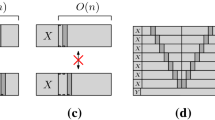Abstract
Self-assembly is a generalization of the crystal growth, which has been proposed as a mechanism for the bottom-up fabrication of autonomous DNA computation. In the same context, tile assembly model is a highly distributed parallel model of natural self-assembly. In this paper, we propose a tile assembly system to tackle a well-known NP-complete problem known as Minimum Vertex Cover problem. The proposed algorithm requires Θ(n×m) types of tiles, and each parallel assembly executes in a linear time, where n is the number of vertices and m is the number of edges. Furthermore, the experimental results proved the simplicity and the efficiency of the proposed algorithm to solve the Minimum Vertex Cover, and reduce the overall complexity to find the solution.














Similar content being viewed by others
References
Feynman RP (1961) There’s plenty of room at the bottom. In: Gilbert HD (ed) Miniaturization. Reinhold, New York, pp 282–296
Head T, Rozenberg G, Bladergroen RB et al (2000) Computing with DNA by operating on plasmids. BioSystems 57:87–93
Lipton RJ (1995) DNA solution of hard computational problem. Science 268(4):542–545
Xu J, Tan G, Fan Y et al (2007) DNA computer principle, advances and difficulties (IV): on the models of DNA computer [J]. Chin J Comput 30(6):881–893
Winfree E et al (1998) Design and self-assembly of two-dimensional DNA crystals. Nature 394:539–544
Fu TJ, Seeman NC (1993) DNA double crossover molecules. Biochemistry 32:3211–3220
Winfree E (1998) Algorithmic self-assembly of DNA [D]. California Institute of Technology, Pasadena, California
Reif JH (2002) Molecular assembly and computation: from theory to experimental demonstrations. In: Proceedings of the twenty-ninth international colloquium on automata, languages and programming, pp 1–21
Robinson RM (1971) Undecidability and nonperiodicity for tilings of the plane. Invent Math 12(3):177–209
Wang Y, Hu P, Zhang X et al (2011) DNA self-assembly for the minimum vertex cover problem. Adv Sci Lett 4(1):74–79(6)
Wang H (1962) Dominoes and the AEA case of the decision problem. In: Proceedings of the symposium in the mathematical theory of automata, Brooklyn. Polytechnic Press, New York, pp 23–55
Chang W-L, Lin KWC, Chen J-C et al (2012) Molecular solutions of the RSA public-key cryptosystem on a DNA-based computer. J Supercomput. doi:10.1007/s11227-011-0627-z
Xiao D, Li W, Zhang Z, He L (2005) Solving maximum cut problems in the Adleman–Lipton model. BioSystems 82:203–207
Dolati A, Haghighat MS, Safaei S, Mozaffar H (2008) Solving minimum beta-vertex separator problems in the Adleman–Lipton model. In: Proceedings of the 2008 international conference on foundations of computer science, FCS 2008, July 14–17, 2008, Las Vegas, Nevada, USA
Winfree E The Xgrow simulator. http://dna.caltech.edu/Xgrow/
Garcia S, Orailoglu A (2009) Making DNA self-assembly error-proof: attaining small growth error rates through embedded information redundancy. In: Proceedings of DATE, pp 898–901
Adleman LM (1994) Molecular computation of solutions to combinatorial problems. Science 266(11):1021–1023
Brun Y (2008) Solving NP-complete problems in the tile assembly model. Theor Comput Sci 395(1):31–46
Brun Y (2008) Arithmetic computation in the tile assembly model: addition and multiplication. Theor Comput Sci 378(1):17–31
Acknowledgements
This work was partially funded by the Key Program of National Natural Science Foundation of China (Grant No. 61133005), and the National Natural Science Foundation of China (Grant Nos. 61070057, 61103047). Key Projects in the National Science & Technology Pillar Program (2012BAH09B02). The Ph.D. Programs Foundation of Ministry of Education of China (20100161110019). The project supported by the National Science Foundation for Distinguished Young Scholars of Hunan (12JJ1011). The Hunan Provincial Science and technology plan project (Grant No. 2012WK3053). The project supported by Scientific Research Fund of Hunan Provincial Education Department (Grant No.12A062). The Project of National Natural Science Foundation of China (Grant 61173013 and 61202109), The Project of the Office of Education in Zhejiang Province (Grant Y201226110).
Author information
Authors and Affiliations
Corresponding author
Rights and permissions
About this article
Cite this article
Wu, F., Li, K., Sallam, A. et al. A molecular solution for minimum vertex cover problem in tile assembly model. J Supercomput 66, 148–169 (2013). https://doi.org/10.1007/s11227-013-0892-0
Published:
Issue Date:
DOI: https://doi.org/10.1007/s11227-013-0892-0








